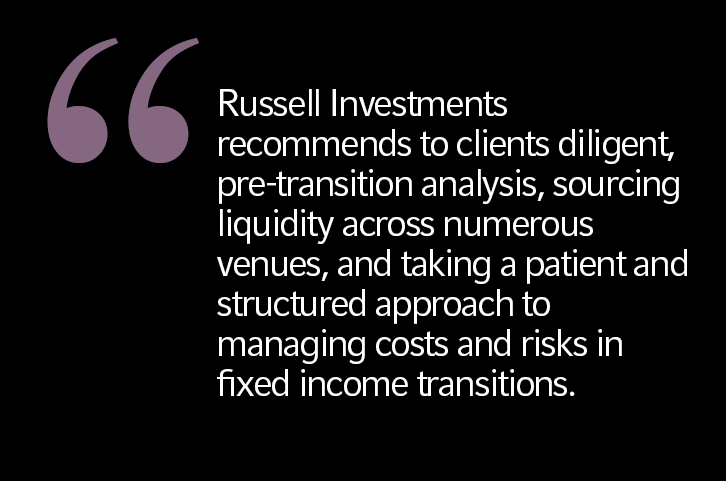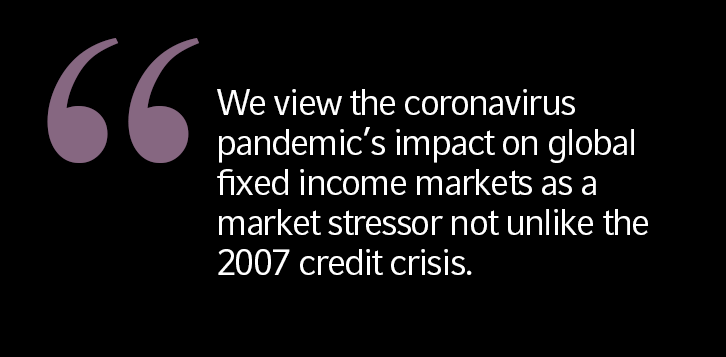Transitioning fixed income assets in fractured markets
The coronavirus pandemic has roiled the global financial markets, with investors struggling to forecast the economic impact of an unprecedented global health crisis. The uncertainty is causing equity returns to fluctuate by triple digit basis points, while the fixed income market is heavily impacted by fragmented liquidity and higher trading costs. Trading fixed income assets since the onset of the pandemic in early 2020 has many similarities to the environment we faced during the credit crisis that began in 2007. Liquidity has become harder to find, risks have multiplied and spread costs are significantly higher than they were just a few months ago. To navigate our clients through the challenging times we face today, Russell Investments has revisited our approach to transitioning fixed income assets during the 2007 credit crisis.
How the credit crisis impacted fixed income transitions
In mid-2007, the fixed income markets were thrown into turmoil by the developing credit crisis. While government bonds remained relatively liquid (and much sought-after by investors seeking safety), all other types of bonds encountered tougher trading circumstances. Structured bonds were especially hard hit, not only those related to home equity, but also commercial mortgage-backed securities and other asset-backed securities. Bid-ask spreads expanded, and trading volumes plummeted, as distressed sellers continued to apply selling pressure, creating a downward spiral in credit conditions.
Although the market circumstances in the late 2000s were uniquely different than those during the coronavirus pandemic, we have learned from the past and from our experience in navigating transitions during stressed markets. We have seen the uncertainty surrounding the pandemic and its potentially long-lasting impact on the global economy to widen spreads on even the most liquid Treasuries, and dealers are taking risk off their balance sheets. Russell Investments recommends diligent pre-transition analysis, sourcing liquidity across numerous venues, and taking a patient and structured approach to managing costs and risks in fixed income transitions.

Pre-transition analysis takes on greater importance
We have always paid close attention to our pre-transition analysis of likely costs and the possible range of outcomes associated with a transition. As markets have become more expensive to trade, as well as more volatile, the importance of that analysis is greater than ever.
Clients need to know the realistic costs associated with their portfolio restructures. Given recent market volatility since the latter half of February, a higher proportion of performance impact is attributable to differences between custodial valuations and actual price quotes in the markets. Clients must be informed of these pricing discrepancies and understand the potential performance impact prior to a trading event. If the likely cost of trading in these markets is prohibitively high, different strategies might be explored. Likewise, knowledge of the main portfolio risks, whether driven by sector weights, curve positioning or credit ratings, can affect the goals and expectations set for a transition.
Further fragmentation of trading venues
Trading transition portfolios has always been more reliant on a broad range of specialist dealers than trading other types of fixed income portfolios. We experienced abnormally fragmented liquidity during the credit crisis, and we see similar patterns today. The ability to work orders and leverage a broad array of relationships is even more important in these times of market stress, as the pricing differential between working orders and principal bids can be substantial. Finding the other side of a trade in fixed income markets can be a question of knowing which electronic platform to engage to find natural liquidity from other buy side firms or specialists in a specific: market, sector or issuer under consideration.
Increased costs and risk
Across a typical actively managed fixed income portfolio, we have witnessed estimated cost of selling a given portfolio to be 25% to 300% higher than it would have been before the pandemic, and the expected cost of buying a given portfolio has also increased, albeit by much less.
The increase in costs is not equally spread across a portfolio. Since the onset of the pandemic, the cost to liquidate investment grade corporate bonds has been dramatically higher; two to three times greater for the energy, basic materials and financial sectors. Treasuries, which were largely unscathed during the credit crisis, have seen bid/offer spreads widen by as much as four times their typical levels. Similarly, the increased risk that is associated with trading in thinner, more volatile markets has put a premium on risk management for fixed income portfolios in transition.
Responding to market challenges: transition choices
Our preferred approach to managing fixed income transitions evolved in response to the market conditions during the credit crisis. We advise clients to employ similar strategies during the current market environment. For example, transition events may be spread out over longer time periods. The design of trading strategies and choice of venues have also been altered in response to the market fragmentation, with an eye to duration management throughout the course of the execution process. But the greatest challenges can lie in trading distressed securities. In many cases, one response we find appropriate is to divide a portfolio into three liquidity categories: a liquid group, a tradeable group with limited liquidity and a distressed portfolio with impaired liquidity.
- The liquid group: Trading securities for which reasonable markets exist
The liquid group is made up of government bonds and other securities for which a ready market with competitive pricing exists. Trading this part of a portfolio generally presents no unusual challenges for a transition manager.
- The tradeable group with limited liquidity
The group with limited liquidity consists of those issues for which a contra-side can be found, but care needs to be exercised in accessing the available liquidity to ensure that the execution price implemented is the best level available at that time. Although this group is more difficult to trade than the liquid portfolio, an experienced fixed income portfolio manager should have the skills required to manage risks and trade it cost-effectively. Indeed, these skills are at the heart of fixed income transition management.
- The distressed portfolio
Today's unusual circumstances have led to the need for a new approach to transition management. The liquidity impaired group consists of securities for which little or no market exists and which can be sold only at distressed prices well below the perceived intrinsic value. The amount of a total portfolio represented by these securities varies and could be between 10% and 20% of a typical active core-plus portfolio.
These assets are put into a separate "workout" portfolio that is passed to a specialist sub-advisor. The sub-advisor will hold the securities for a prolonged period, trading out of them for 12 months or more (potentially years in some cases) until acceptable pricing begins to be available again. Often the sub-advisor makes the credit judgment based on in-depth credit and structural analysis to simply hold the position until maturity, which maximizes the value of the asset for the client.
Workout portfolio assignments first appeared in mid-2008—and there are now roughly half a dozen firms offering this niche sub-advisor service. Of these, the most appropriate choice for specific scenario will depend on the nature of the assets and portfolio size, among other factors.
With a workout portfolio approach, clients avoid becoming forced sellers in a distressed market and hope to realize the economic value of their investments through an orderly trading strategy, or the final maturity of instruments. For a client facing the prospect of selling fixed income securities into today's market at distressed prices, avoiding forced sales through workout portfolios can lead to significantly better outcomes—assuming perceived economic value becomes a reality at some point in the future.

Conclusion: Learning from past experiences
We view the coronavirus pandemic’s impact on global fixed income markets as a market stressor not unlike the 2007 credit crisis. The operation of fixed income markets, even more than equity markets, has been fractured and transaction costs and risks are significantly increased. It may be some time before liquidity and trading costs stabilize and return to their mean levels. In response to these unusual times, our fixed income transition approach has incorporated these and other innovative approaches to help ensure the best outcomes for our clients.